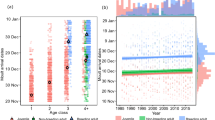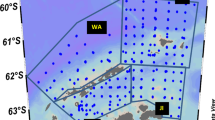Abstract
The interactions between moult phasing, growth and environmental cues in Northern krill (Meganyctiphanes norvegica) were examined through analysing populations at seasonal, weekly, and daily timescales. The analyses were carried out on resident populations of krill found in three different neritic locations that experience similar environmental signals (the Clyde Sea, Scotland; the Kattegat, Denmark; Gullmarsfjord, Sweden). Seasonal analyses were carried out on the Clyde Sea population and showed that moulting frequency increased significantly moving from winter to summer. The proportion of moulting females in summer samples was often more than double the proportion of moulting males, suggesting that females had a comparatively shorter intermoult period (IMP). Weekly samples taken from the Kattegat showed a similar pattern. However, although the difference between the proportion of female and male moulters was significant in one week, it was not another, mainly because of the variability in the proportion of female moulters. Such variability in females was equally evident in the daily samples taken at Gullmarsfjord. It suggests that females have a shorter IMP (12.5 days) than males (18.4 days) and are more likely to moult in synchrony. Nevertheless, the daily samples revealed that males are also capable of moult synchronisation, although less frequently than females. Shortened IMPs in females were not a result of the abbreviation of specific moult stages. Accordingly, reproductive activity did not alter the course of the normal moult cycle. There was no significant difference between the total body lengths of males and females indicating that females achieve the same levels of growth despite moulting more frequently and having to provision the energy-rich ovaries. This is in contrast to most other crustaceans where the energy costs of reproduction reduce female growth. The fact that females were less abundant than males, probably by suffering a greater level of mortality, suggests that different behavioural strategies, particularly vertical migration regimes, were adopted by each sex to maximise growth and reproduction.





Similar content being viewed by others
References
Anderson SL, Wallis HC, Chang ES (1985) Multiple spawning and molt synchrony in a free spawning shrimp (Sicyonia ingentis: Penaeoidea). Biol Bull 168:377–394
Boysen E, Buchholz F (1984) Meganyctiphanes norvegica in the Kattegat. Studies on the development of a pelagic population. Mar Biol 79:195–207
Buchholz F (1982) Drach’s molt staging system adapted for euphausiids. Mar Biol 66:301–305
Buchholz F (1985) Moult and growth in euphausiids. In: Siegfried WR, Condy P, Laws RM (eds) Antarctic nutrient cycles and food webs. Springer, Berlin Heidelberg New York, pp 339–345
Buchholz F (1991) Moult cycle and growth of Antarctic krill, Euphausia superba, in the laboratory. Mar Ecol Prog Ser 69:217–229
Buchholz F, Watkins JL, Priddle J, Morris DJ, Ricketts C (1996) Moult in relation to some aspects of reproduction and growth in swarms of Antarctic krill, Euphausia superba. Mar Biol 127:201–208
Capriulo GM, Pedone MJ, Small EB (1991) High apostome ciliate endoparasite infection rates found in the Bering Sea euphausiid Thysanoessa inermis. Mar Ecol Prog Ser 72:203–204
Conan GY (1985) Periodicity and phasing of molting. In: Schram FA, Wenner AM (eds) Crustacean Issues 3. A. A. Balkema, Rotterdam, pp 73–99
Cuzin-Roudy J (2000) Seasonal reproduction, multiple spawning, and fecundity in northern krill, Meganyctiphanes norvegica, and Antarctic krill, Euphausia superba. Can J Fish Aquat Sci 57:6–15
Cuzin-Roudy J, Buchholz F (1999) Ovarian development and spawning in relation to the moult cycle in Northern krill, Meganyctiphanes norvegica (Crustacea: Euphausiacea), along a climatic gradient. Mar Biol 133:267–281
Cuzin-Roudy J, Tarling GA, Strömberg J-O (2004) Life cycle strategies of Northern krill (Meganyctiphanes norvegica) for regulating growth, moult, and reproductive activity in various environments: the case of fjordic populations. ICES J Mar Sci 61:721–737
De Lafontaine Y, Demers S, Runge J (1991) Pelagic food web interactions and productivity in the Gulf of St Lawrence: A perspective. In: J-C. Therriault (ed) The Gulf of St. Lawrence: small ocean or big estuary? NRC Research Press, Ottawa, Canada, pp 99–123
Fowler SW, Small LF, Keckeš S (1971) Effects of temperature and size on molting of euphausiid crustaceans. Mar Biol 11:45–51
Gomez-Gutierrez J, Peterson WT, De Robertis A, Brodeur RD (2003) Mass mortality of krill caused by parasitoid ciliates. Science 301:339
Hamner WM, Hamner PP, Strand SW, Gilmer RW (1983) Behavior of Antarctic krill, Euphausia superba: chemoreception, feeding, schooling, and molting. Science (Washington) 220:433–435
Hartnoll RG (1982) Growth. In: Bliss DE, Abele LG (eds) The biology of crustacea, vol 2. Academic, New York, pp 111–196
Hartnoll RG (1985) Growth, sexual maturity and reproductive output. In: Schram FA, Wenner AM (eds) Crustacean Issues 3. A.A. Balkema, Rotterdam, pp 101–128
Hartnoll RG (2001) Growth in Crustacea—twenty years on. Hydrobiologia 449:111–122
Ikeda T, Thomas PG (1987) Moulting interval and growth of juvenile Antarctic krill (Euphausia superba) fed different concentrations of the diatom Phaeodactylum tricornutum in the laboratory. Polar Biol 7: 339–343
Kaartvedt S, Rostad A, Fiksen O, Melle W, Torgersen T, Tiseth-Breien M, Klevjer TA (2005) Piscovorous fish patrol krill swarms. Mar Ecol Prog Ser 299:1–5
Lasker R (1966) Feeding, growth, respiration, and carbon utilization of a euphausiid crustacean. J Fish Res Board Can 23:1291–1317
Lindley JA (1978) Continuous plankton records: the occurrence of apostome ciliates (Protozoa) on Euphausiacea in the North Atlantic Ocean and North Sea. Mar Biol 46:131–136
Mauchline J (1980) The biology of mysids and euphausiids. Academic, London, New York, Toronto, Sydney, San Francisco
Mauchline J, Fischer LR (1969) The biology of euphausiids. Academic, London, New York
Nelson K (1991) Scheduling of reproduction in relation to molting and growth in malacostracan crustaceans. In: Schram FA, Wenner AW, Kuris A (eds) Crustacean Issues 7. A. A. Balkema, Rotterdam, Brookfield, pp 77–113
Nicol S (1984) Ephelota sp., a suctorian found on the euphausiid Meganyctiphanes norvegica. Can J Zool 62:744–745
Quetin LB, Ross RM, Frazer TK, Amsler MO, Wyatt Evens C, Oakes SA (2003) Growth of larval krill, Euphausia superba, in fall and winter West of the Antarctic Peninsula. Mar Biol 143:833–843
Rakusa-Suszczewski S, Filcek K (1988) Protozoa on the body of Euphausia superba Dana from Admiralty Bay (the South Shetland Islands). Acta Protozool 27:21–30
Schmidt K, Tarling GA, Plathner N, Atkinson A (2004) Moult cycle-related changes in feeding rates of larval krill Meganyctiphanes norvegica and Thysanoessa spp. Mar Ecol Prog Ser 281:131–143
Siegel PR (1984) Food-induced size-specific molt synchrony of the sand crab, Emerita analoga (Stimpson). Biol Bull 167:579–589
Stankovic A, Borsuk P, Koper M, Weglenski P (2002) Studies on Ephelota sp., an epizoic suctorian found on Antarctic krill. Polar Biol 25:827–832
Tarling G (2003) Sex-dependent diel vertical migration in northern krill Meganyctiphanes norvegica and its consequences for population dynamics. Mar Ecol Prog Ser 260:173–188
Tarling GA, Cuzin-Roudy J (2003) Synchronization in the molting and spawning activity of Northern krill (Meganyctiphanes norvegica) and its effect on recruitment. Limnol Oceanogr 48:2020–2033
Tarling GA, Cuzin-Roudy J, Buchholz F (1999) Vertical migration behaviour in the Northern krill Meganyctiphanes norvegica is influenced by moult and reproductive processes. Mar Ecol Prog Ser 190:253–262
Tarling GA, Shreeve RS, Hirst AG, Atkinson A, Pond DW, Murphy EJ, Watkins JL (2006) Natural growth rates in Antarctic krill (Euphausia superba): I. Improving methodology and predicting intermolt period. Limnol Oceanogr 51:959–972
Thomasson MA, Johnson ML, Strömberg J-O, Gaten E (2003) Swimming capacity and pleopod beat rate as a function of sex, size and moult stage in Northern krill Meganyctiphanes norvegica. Mar Ecol Prog Ser 250:205–213
Wiebe PH, Morton AW, Bradley AM, Craddock JE, Cowles TJ, Barber VA, Backus RH, Flierli GR (1985) New developments in the MOCNESS, an apparatus for sampling zooplankton and micronekton. Mar Biol 87:313–323
Acknowledgements
The hospitality and efficient support at Kristineberg Marine Research Station and the kind help of Jalle Strömberg are gratefully acknowledged. The scientific and ship’s crew of FS “Heincke” contributed substantially to the sampling in the Kattegat, as well as those on RV “Calanus” in the Clyde Sea and on RV “Oskar von Sydow” in the Gullmarsfjord. Janine Cuzin is thanked for her eager interest in our work and hours of discussion. The work was supported by grants from the Transnational Access funds to KMRS and EU-MAST III (MAS3-CT95-0013), “The PEP Programme.” Fieldwork in the Clyde, carried out by GT, was funded by a NERC postdoctoral fellowship (GST/59818MS). GT’s contribution to the data analysis was carried out as part of the FLEXICON project of the DISCOVERY 2010 programme at BAS. We wish to express our gratitude to three anonymous advisors who spent their time and consideration to help us improve the manuscript.
Author information
Authors and Affiliations
Corresponding author
Additional information
Communicated by O. Kinne, Oldendorf/Luhe
Rights and permissions
About this article
Cite this article
Buchholz, C.M., Buchholz, F. & Tarling, G.A. On the timing of moulting processes in reproductively active Northern krill Meganyctiphanes norvegica . Mar Biol 149, 1443–1452 (2006). https://doi.org/10.1007/s00227-006-0317-1
Received:
Accepted:
Published:
Issue Date:
DOI: https://doi.org/10.1007/s00227-006-0317-1




